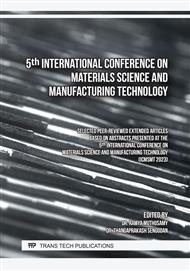[1]
A. Ali et al., "Hydrophobic treatment of natural fibers and their composites—A review," J. Ind. Text., vol. 47, no. 8, p.2153–2183, 2018.
Google Scholar
[2]
N. Kumar, A. Singh, and K. Debnath, "Influence of fiber weight ratio on the mechanical and water absorption performance of borassus/epoxy composites," Mater. Test., vol. 62, no. 9, p.937–942, 2020.
DOI: 10.3139/120.111569
Google Scholar
[3]
Siakeng, R., Jawaid, M., Ariffin, H., & Sapuan, S. M. (2018). Physical properties of coir and pineapple leaf fibre reinforced polylactic acid hybrid composites. IOP Conference Series: Materials Science and Engineering, 290(1).
DOI: 10.1088/1757-899X/290/1/012031
Google Scholar
[4]
S. S. Todkar and S. A. Patil, "Review on mechanical properties evaluation of pineapple leaf fibre (PALF) reinforced polymer composites," Compos. Part B Eng., vol. 174, no. May, p.106927, 2019.
DOI: 10.1016/j.compositesb.2019.106927
Google Scholar
[5]
J. Jain, S. Jain, and S. Sinha, "Characterization and thermal kinetic analysis of pineapple leaf fibers and their reinforcement in epoxy," 2018.
DOI: 10.1177/0095244318783024
Google Scholar
[6]
M. Mittal, "Biodegradability and mechanical properties of Pineapple Leaf/Coir Fiber reinforced hybrid epoxy composites," Mater. Res. Express, p.30, 2018.
DOI: 10.1088/2053-1591/aaf8d6
Google Scholar
[7]
N. Lopattananon, K. Panawarangkul, K. Sahakaro, and B. Ellis, "Performance of pineapple leaf fiber-natural rubber composites: The effect of fiber surface treatments," J. Appl. Polym. Sci., vol. 102, no. 2, p.1974–1984, 2006.
DOI: 10.1002/app.24584
Google Scholar
[8]
S. M. Sapuan, A. R. Mohamed, J. P. Siregar, and M. R. Ishak, "Cellulose Fibers: Bio- and Nano-Polymer Composites," Cellul. Fibers Bio- Nano-Polymer Compos., p.325–343, 2011.
DOI: 10.1007/978-3-642-17370-7_12
Google Scholar
[9]
N. Kengkhetkit and T. Amornsakchai, "Utilisation of pineapple leaf waste for plastic reinforcement: 1. A novel extraction method for short pineapple leaf fiber," Ind. Crops Prod., vol. 40, no. 1, p.55–61, 2012.
DOI: 10.1016/j.indcrop.2012.02.037
Google Scholar
[10]
M. M. Kabir, H. Wang, K. T. Lau, and F. Cardona, "Chemical treatments on plant-based natural fibre reinforced polymer composites: An overview," Compos. Part B Eng., vol. 43, no. 7, p.2883–2892, 2012.
DOI: 10.1016/j.compositesb.2012.04.053
Google Scholar
[11]
V. R. A. Prakash and S. J. Jaisingh, "Mechanical Strength Behaviour of Silane Treated E-glass Fibre/Al 6061 & SS-304 Wire Mesh Reinforced Epoxy Resin Hybrid Composite," Silicon, vol. 10, no. 5, p.2279–2286, 2018.
DOI: 10.1007/s12633-018-9762-y
Google Scholar
[12]
P. Krishnasamy, G. Rajamurugan, and M. Thirumurugan, "Dynamic mechanical characteristics of jute fiber and 304 wire mesh reinforced epoxy composite," J. Ind. Text., vol. 51, no. 4, p.540–558, 2021.
DOI: 10.1177/1528083719883057
Google Scholar
[13]
P. krishnasamy, G. Rajamurugan, S. Aravindraj, and P. E. Sudhagar, "Vibration and Wear Characteristics of Aloevera/Flax/Hemp Woven Fiber Epoxy Composite Reinforced with Wire Mesh and BaSO4," J. Nat. Fibers, vol. 19, no. 8, p.2885–2901, 2022.
DOI: 10.1080/15440478.2020.1835782
Google Scholar
[14]
T. Loganathan, K. Vinoth Kumar, K. Ayyappa, G. Mahendran, and G. Venkatachalam, "Mechanical and Vibrational Property Evaluation of Banana Fiber Epoxy Sandwich Composite with Steel Wire Mesh Core," J. Nat. Fibers, vol. 19, no. 11, p.4024–4037, 2022.
DOI: 10.1080/15440478.2020.1848744
Google Scholar
[15]
M. A. Murugan et al., "Low Velocity Impact and Mechanical Behaviour of Shot Blasted SiC Wire-Mesh and Silane-Treated Aloevera/Hemp/Flax-Reinforced SiC Whisker Modified Epoxy Resin Composites," Silicon, vol. 12, no. 8, p.1847–1856, 2020.
DOI: 10.1007/s12633-019-00297-0
Google Scholar
[16]
M. Ramesh, J. D. J. Dhilip, S. Akilan, B. Ganeshprasad, and G. H. Shankar, "Influence of Stacking Sequence on Mechanical and Thermal Characteristics of Banana-Pineapple Fiber Reinforced Epoxy Composites," J. Nat. Fibers, vol. 19, no. 10, p.3879–3892, 2022.
DOI: 10.1080/15440478.2020.1848734
Google Scholar
[17]
R. Potluri, "Mechanical Properties of Pineapple Leaf Fiber Reinforced Epoxy Infused with Silicon Carbide Micro Particles," J. Nat. Fibers, vol. 16, no. 1, p.137–151, 2019.
DOI: 10.1080/15440478.2017.1410511
Google Scholar
[18]
N. Lopattananon, K. Panawarangkul, K. Sahakaro, and B. Ellis, "Performance of pineapple leaf fiber-natural rubber composites: The effect of fiber surface treatments," J. Appl. Polym. Sci., vol. 102, no. 2, p.1974–1984, 2006.
DOI: 10.1002/app.24584
Google Scholar
[19]
K. Z. M. A. Motaleb, M. S. Islam, and M. B. Hoque, "Improvement of Physicomechanical Properties of Pineapple Leaf Fiber Reinforced Composite," Int. J. Biomater., vol. 2018, 2018.
DOI: 10.1155/2018/7384360
Google Scholar
[20]
E. W. Gaba, B. O. Asimeng, E. E. Kaufmann, S. K. Katu, E. J. Foster, and E. K. Tiburu, "Mechanical and structural characterization of pineapple leaf fiber," Fibers, vol. 9, no. 8, p.1–11, 2021.
DOI: 10.3390/fib9080051
Google Scholar
[21]
T. P. Sathishkumar, J. Naveen, P. Navaneethakrishnan, S. Satheeshkumar, and N. Rajini, "Characterization of sisal/cotton fibre woven mat reinforced polymer hybrid composites," J. Ind. Text., vol. 47, no. 4, p.429–452, 2017.
DOI: 10.1177/1528083716648764
Google Scholar
[22]
P. B A, B. P Shetty, V. N, S. H V, S. P. Singh Yadav, and A. L, "Mechanical properties and water absorption behaviour of pineapple leaf fibre reinforced polymer composites," Adv. Mater. Process. Technol., vol. 8, no. 2, p.1336–1351, 2022.
DOI: 10.1080/2374068x.2020.1860354
Google Scholar
[23]
P. K. Kushwaha and R. Kumar, "Influence of chemical treatments on the mechanical and water absorption properties of bamboo fiber composites," J. Reinf. Plast. Compos., vol. 30, no. 1, p.73–85, 2011.
DOI: 10.1177/0731684410383064
Google Scholar
[24]
N. Kumar, A. Singh, and K. Debnath, "Influence of surface modification on the performance of borassus fruit fiber composites," Emerg. Mater. Res., vol. 9, no. 3, p.686–694, 2020.
DOI: 10.1680/jemmr.19.00067
Google Scholar
[25]
S. Chaitanya and I. Singh, "Novel Aloe Vera fiber reinforced biodegradable composites - Development and characterization," J. Reinf. Plast. Compos., vol. 35, no. 19, p.1411–1423, 2016.
DOI: 10.1177/0731684416652739
Google Scholar
[26]
V. R. Arun Prakash and A. Rajadurai, "Mechanical, thermal and dielectric characterization of iron oxide particles dispersed glass fiber epoxy resin hybrid composite," Dig. J. Nanomater. Biostructures, vol. 11, no. 2, p.373–380, 2016.
Google Scholar
[27]
N. Domun, H. Hadavinia, T. Zhang, T. Sainsbury, G. H. Liaghat, and S. Vahid, "Improving the fracture toughness and the strength of epoxy using nanomaterials-a review of the current status," Nanoscale, vol. 7, no. 23, p.10294–10329, 2015.
DOI: 10.1039/c5nr01354b
Google Scholar



